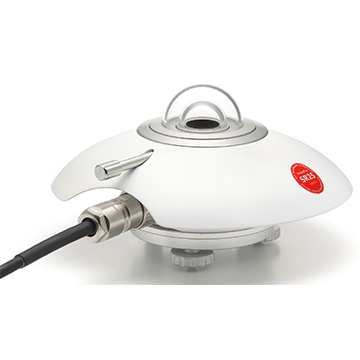
SR25-D2 represents the next level in solar radiation measurement. Using a sapphire outer dome, it has negligible zero offsets. SR25-D2 is heated in order to suppress dew and frost deposition, maintaining its high measurement accuracy. When heating SR25-D2, the data availability and accuracy are higher than when ventilating traditional pyranometers. In addition, SR25-D2 needs very low power; heating only consumes 1.5 W compared to the usual 10 W for ventilation. The low thermal offsets make SR25-D2 very suitable for measuring diffuse radiation. Patents on the SR25-D2 working principle are pending.
SR25-D2 offers two types of commonly used outputs: digital via Modbus RTU over RS-485 and analogue 4-20 mA (current loop). These industry standards allow for easy data acquisition, easy read-out and error-free instrument exchange. The instrument is also available with analogue millivolt output (as SR25).
Best data availability
By keeping the SR25-D2 outer dome free of dew and frost with help of the internal heater, data availability is highly increased over traditional pyranometers, whether these are ventilated or not. The application photo in the image gallery shows the clear difference between SR25 (on the left side of the photo) versus a non-heated pyranometer without sapphire dome (on the right).
Best measurement accuracy
SR25-D2 measures the solar radiation received by a plane surface, in W/m2, from a 180 o field of view angle. SR25-D2 offers the best measurement accuracy: the specification limits of two major sources of measurement uncertainty have been greatly improved over competing pyranometers: “zero offset a” and temperature response. Test certificates for temperature response and directional response are included: all sensors are tested individually for ISO 9060 compliance.
SR25-D2 pyranometer design
SR25-D2 has a sapphire outer dome, glass inner dome and an internal heater. It employs a state-of-the-art thermopile sensor with black coated surface and an anodised aluminium body. The connector, desiccant holder and sun screen fixation are very robust and designed for long term use. SR25-D2 uses a high-end 24-bit A/D converter. All parts are specified for use across SR25-D2’s entire rated operating temperature range. SR25-D2 offers two types of outputs: digital output via Modbus RTU over 2-wire RS-485 and analogue 4-20 mA output (current loop).
SR25 is delivered in a solid HPRC case. See the image gallery for a visual representation.
Hukseflux Sensor Manager software
For communication between a PC and SR25-D2, the Hukseflux Sensor Manager software is included. It allows the user to plot and export data, and change the SR25-D2 Modbus address and its communication settings. The latest Hukseflux Sensor Manager software for SR25-D1 can be found here.
Suggested use
• all situations where ventilated pyranometers are employed
• all networks with regular instrument exchange
• PV system performance monitoring
• indoor PV testing with solar simulators
• airborne measurements
• diffuse measurements
• environments with dew
• environments with frost
Options
• longer cable, in multiples of 5 metres












